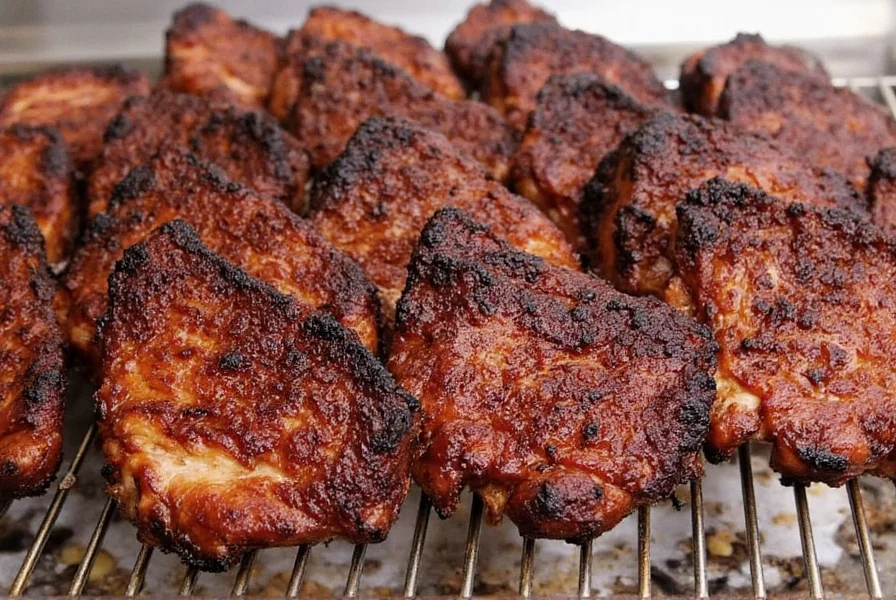Smoking ribs to perfection requires understanding both science and sensory cues. Many beginners rely solely on cooking time, but variables like meat thickness, smoker temperature fluctuations, and rib type make time an unreliable indicator. The most accurate method combines internal temperature measurement with visual and tactile tests.
The Science Behind Perfectly Smoked Ribs
Understanding the transformation that occurs during smoking helps you recognize true doneness. Ribs contain significant collagen, which begins converting to gelatin at 160°F (71°C) but requires sustained heat between 195-205°F (90-96°C) to fully break down. This process, called rendering, creates that signature fall-off-the-bone texture without drying out the meat.
Temperature Guidelines for Different Rib Types
While the 195-205°F range applies broadly, slight variations exist between rib types. Always measure temperature in the thickest part of the meat, avoiding bones which conduct heat differently.
| Rib Type | Optimal Internal Temperature | Texture Characteristics |
|---|---|---|
| St. Louis Cut Pork Ribs | 195-203°F (90-95°C) | Firm yet flexible, meat retracts 1/2 inch from bones |
| Baby Back Ribs | 190-200°F (88-93°C) | More tender, slightly less bend required |
| Beef Back Ribs | 200-205°F (93-96°C) | Denser meat requires higher temperature |
| Spare Ribs | 195-205°F (90-96°C) | Meat shrinks significantly from bones |
The Bend Test: Your Visual Doneness Indicator
When your ribs approach target temperature, perform the bend test. Using sturdy tongs, lift the rack from one end. Properly cooked ribs will bend dramatically, forming a U-shape rather than staying rigid. Small cracks should appear on the bark surface, but the meat shouldn't separate completely.
Many home smokers mistakenly pull ribs when they bend slightly at 180-185°F. While edible, this temperature leaves collagen partially intact, resulting in chewy rather than tender ribs. The bend test becomes reliable only when combined with temperature verification.
Probe Test: Assessing Tenderness Without a Thermometer
If you don't have a thermometer, the probe test offers a reliable alternative. Insert a skewer or meat probe into the thickest part of the rack. When properly smoked, the probe should slide in with little resistance, similar to warm butter. You'll feel minimal pushback compared to undercooked ribs, which offer significant resistance.
This method works best when comparing multiple spots across the rack. Consistent tenderness throughout indicates even cooking. Remember that bone-in sections may feel slightly firmer than meat-only areas.

Visual Indicators of Perfectly Smoked Ribs
Beyond temperature and bend tests, several visual cues confirm doneness:
- Meat retraction: The meat should pull back from the bones by about 1/2 to 1 inch, exposing more of the bone ends
- Bark appearance: The exterior develops small cracks but remains intact, not burnt or flaking excessively
- Fat rendering: Visible fat caps become translucent and shrink significantly
- Juice clarity: When pierced, juices run clear rather than pink or red
Common Mistakes in Determining Rib Doneness
Even experienced smokers make these critical errors when judging when ribs are done smoking:
- Trusting time over temperature: "3-2-1 method" timers don't account for meat thickness or temperature fluctuations
- Single-point temperature reading: Checking only one spot instead of multiple locations across the rack
- Misinterpreting the bend test: Pulling ribs when they bend slightly at 180°F rather than the dramatic bend at 200°F+
- Ignoring carryover cooking: Not accounting for 5-10°F temperature rise during resting
Resting: The Critical Final Step
Never skip resting your smoked ribs. After reaching target temperature, wrap them tightly in butcher paper or aluminum foil and place in an insulated cooler or warm oven (170°F) for 30-60 minutes. This allows:
- Temperature equalization throughout the meat
- Complete collagen-to-gelatin conversion
- Juice redistribution for maximum moisture retention
- Carryover cooking to reach ideal final temperature
Skipping this step often results in ribs that seem done when cut but become dry and stringy as they cool.
Troubleshooting Doneness Issues
If ribs haven't reached target temperature: Continue smoking, checking every 15-20 minutes. If the bark is darkening too quickly, wrap in foil with a splash of apple juice to prevent drying.
If ribs exceed 205°F but remain tough: This indicates the smoker temperature was too low, preventing proper rendering. Increase temperature to 250°F and continue cooking while monitoring closely.
If ribs are falling apart at 190°F: You likely have thinner cuts or the smoker ran hotter than expected. Check other indicators like meat retraction to confirm true doneness.










 浙公网安备
33010002000092号
浙公网安备
33010002000092号 浙B2-20120091-4
浙B2-20120091-4